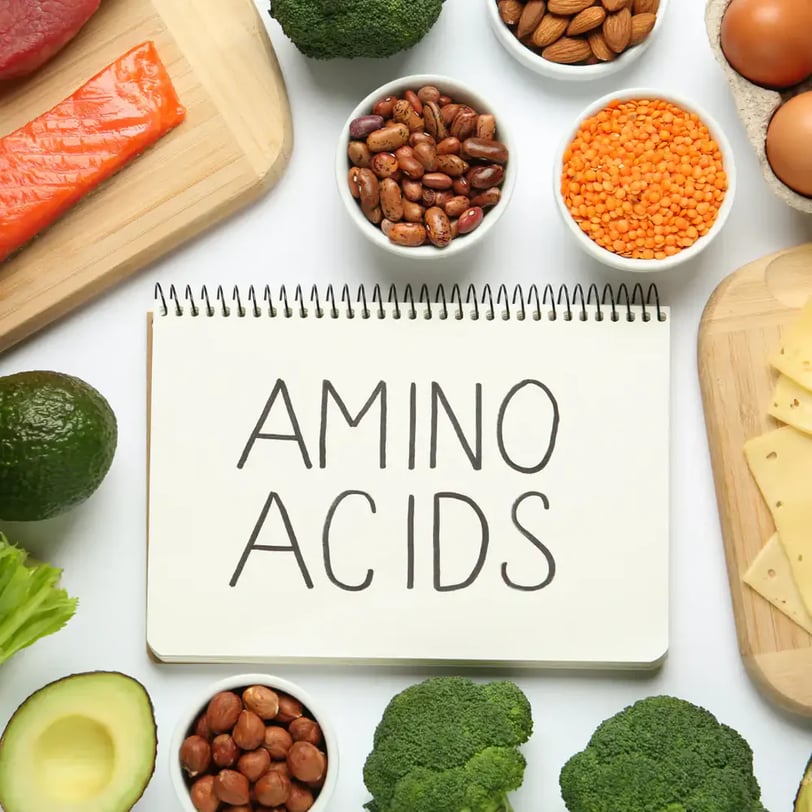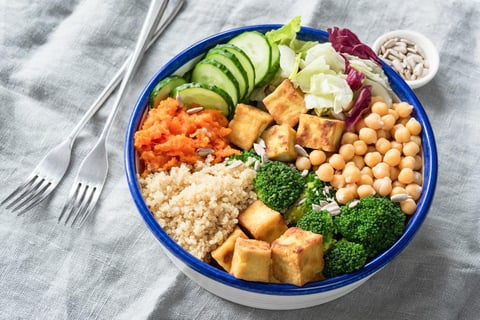Build a Stronger, More Beautiful You—Through Strength Training, Nutrition, and Community.
Amino Acids – The Basis for Essential Proteins
Explore the essential role that amino acids and proteins play in supporting your body’s functions and structure. Learn about the 20 key amino acids, their classification into essential, semi-essential, and non-essential, and how each type contributes to muscle growth, metabolism, and overall health. This comprehensive guide also covers the importance of consuming balanced sources of protein through diet or supplements, the risks of protein deficiency, and how amino acids are crucial for maintaining a healthy and active lifestyle. Understand the science behind protein metabolism and its impact on your well-being.
HEALTH &NUTRITION
10/15/20246 min read


Proteins are among the most important building blocks of the human body and perform many vital functions. They are present in every cell, help build skin, connective tissue, and muscles, regulate the transport of oxygen and nutrients in cells, and strengthen our immune system. A smooth energy and metabolic process would not be possible without certain enzyme-proteins that act as biological catalysts. A protein itself is made up of a combination of amino acids, and these variations are present in all living organisms.
Amino Acids – What Are They?
An amino acid is a chemical compound with two functional groups. The amino group contains nitrogen and hydrogen, while the carboxyl group contains carbon, oxygen, and hydrogen in different compositions. For humans, 20 amino acids are particularly important, although many more variations occur in nature. These are also referred to as proteinogenic amino acids ("tissue-forming"). The 20 amino acid building blocks are, in alphabetical order:
Alanine
Arginine
Asparagine
Aspartic acid
Cysteine
Glutamine
Glutamic acid
Glycine
Histidine
Isoleucine
Leucine
Lysine
Methionine
Phenylalanine
Proline
Serine
Threonine
Tryptophan
Tyrosine
Valine
Division of Amino Acids into Three Classes
These 20 amino acids are divided into three classes based on chemical principles and their significance in human nutrition: essential, semi-essential, and non-essential amino acids. We’ll briefly describe these differences.
Essential Amino Acids
There are eight essential amino acids that the human body cannot produce on its own:
Leucine
Isoleucine
Valine
Lysine
Threonine
Phenylalanine
Methionine
Tryptophan
Therefore, we must necessarily obtain them through food or amino acid supplements. They are especially responsible for muscle building, where non-essential protein building blocks play little to no role.
Semi-Essential Amino Acids
Under optimal health conditions, the human body can form semi-essential amino acids from essential ones. However, when impaired by factors such as stress, growth phases, or severe illnesses, this production decreases. In such cases, we must also obtain them through food.
Non-Essential Amino Acids
With a balanced diet and healthy lifestyle, the body produces non-essential amino acids in sufficient quantities. Therefore, they do not need to be obtained from food.
How Are Amino Acids from Food Turned into Body Proteins?
We need amino acids to build our own body proteins. To extract amino acids from the proteins in food, several steps are required. Dietary proteins are broken down and decomposed by enzymes in the digestive tract. The free amino acids then enter the bloodstream and are transported to the liver, where they are available for the body to use in forming its own proteins.
What Is the Amino Acid Pool?
Unlike fats and carbohydrates, humans cannot store proteins directly. Only a certain portion of free amino acids can be stored in the so-called amino acid pool. This means that we must continuously consume amino acids through meals to prevent the breakdown of body protein. When we consume more protein than our metabolism needs, the excess amino acids are stored in the pool after digestion. Once the pool is full, the amino acids are used for energy production. The nitrogen contained in them is mostly excreted through urine.


What Is the Amino Acid Requirement?
The World Health Organization (WHO) recommends a daily intake of about 184 mg of amino acids per kilogram of body weight through a balanced diet. For a person weighing 80 kg, this equates to about 15 grams. This can be easily achieved with a combination of plant and animal protein sources. Experts refer to sources that sufficiently supply the body with essential amino acids as "complete protein sources." These are typically animal foods, while plants often lack one or more essential amino acids. This is something vegans, in particular, should be aware of when consuming amino acids. Vegans can combine fruits, vegetables, and other meatless foods so that their amino acid content complements one another. If you want to consume essential amino acids on a vegan diet, supplements may be useful.
From Amino Acids to Proteins
Proteins are created from amino acids through highly complex chemical processes. Our muscles, skin, and all other types of body tissue depend on proteins—and, therefore, amino acids—as their fundamental building blocks. The specific amino acid sequence of a protein is encoded in DNA, and this has changed very little over the course of evolution. In the ribosomes of the cells, the "production machinery" for proteins, DNA information is used to form amino acid chains. These chains eventually give rise to protein molecules. When a protein-deficient diet occurs, the body compensates for the amino acid deficiency by breaking down existing body protein. This can lead to muscle atrophy in such circumstances. Many experts believe that aging processes in the skin are also linked to protein metabolism, although the exact relationships are still not fully understood scientifically.
The Importance of Proteins for Metabolism
The importance of proteins to our bodies is highlighted by the fact that they are present in every cell. They generally make up more than 50% of our dry body weight. Proteins can be thought of as molecular-sized tools, performing various tasks depending on their structure. They enable cell movement, transport metabolites (intermediary products of metabolism), catalyze chemical reactions, and recognize signaling and messenger substances. Proteins are also essential for healing diseases or wounds. Moreover, muscles, the heart, the brain, the skin, and hair are predominantly made of proteins. Based on their functions, proteins can be divided into:
Structural proteins
Motor proteins
Signal proteins
Transport proteins
Storage proteins
Enzyme proteins
Proteins as the Basis for Other Important Substances
Two examples demonstrate the importance of proteins—and thus amino acids—for our bodies.
Serotonin, a neurotransmitter, ensures the transmission of specific signals to receptors in our brain. It is closely related to good sleep, calmness, and overall mood. A lack of serotonin can lead to poor sleep and a generally low mood. Tryptophan, an essential amino acid, is primarily responsible for the formation of serotonin. Since the body cannot produce tryptophan itself, it must be obtained from food.
The important thyroid hormone T4 is also formed from the non-essential amino acid tyrosine in a conversion process. T4 controls numerous body functions and metabolic processes, such as energy expenditure and adaptation to cold. The hormone is involved in fat breakdown (lipolysis) and provides energy for the body from fatty acids and sugars.
What Is Our Protein Requirement?
The highest protein demand, relative to body weight, occurs during the growth phases after birth. An infant in the first month requires around 2.5 grams of protein per kilogram of body weight. After one year, about 1.3 grams per kilogram is sufficient. The demand in toddlers is higher than in older children or adolescents, and the need in young adults is lower than in seniors over 65. Increased intake is also recommended for pregnant women and breastfeeding mothers. Here are the recommendations from the German Nutrition Society:
Infants in the first month: 2.5 g/kg
Toddlers after 12 months: 1.3 g/kg
Older children: 1.0 g/kg
Adolescents: 0.9 g/kg
Young adults: 0.8 g/kg
Seniors over 65: 1.0 g/kg
Pregnant women: 1.0 g/kg
Breastfeeding mothers: 1.2 g/kg
What Happens in Case of Protein Deficiency?
When the body receives too little protein, numerous symptoms, conditions, and illnesses can occur. These include reduced hair pigmentation, growth delays, liver enlargement, muscle weakness, and mental apathy. Prolonged protein deficiency can lead to death, depending on the individual's initial condition and the length of the deficiency. In industrialized nations, protein deficiency is rare due to the good food supply, unless people consciously choose a very low-protein diet. For example, in Germany, the average mixed diet contains about 100 grams of protein per day, more than enough for an adult.
Maintain a Healthy Diet Even While Losing Weight
Amino acid supplements Those who live normally and eat a balanced diet do not need to fear a protein deficiency. However, there are life phases and situations where your protein needs may be higher. In such cases, amino acid supplements can be helpful. Amino acid supplements are recommended for:
People on a calorie-reduced diet
Athletes, especially if they want to not only maintain but also build muscle
Older people
People affected by illness or stress
Amino Acids and Proteins Are Indispensable
In this text, we have aimed to show how important amino acids and proteins are for the function and structure of the human body. Protein deficiency leads to serious health problems over time. To produce the body’s own proteins, which cannot be supplied through food, we need the amino acid complex. However, a portion of these amino acids must necessarily be supplied from external sources, as we cannot generate all of them on our own. Each of the 20 amino acid building blocks has a special role to play. If you wish to take these essential building blocks in the form of supplements, ensure they are of high premium quality. As manufacturers, we follow the recommendations of the WHO and recognized scientists. These products are usually available in powder form or as tablets. Be sure to choose products free from additives, as these can negatively affect bioavailability.
Follow us on Social Media!
Join our movement today!
© 2025. All rights reserved.


